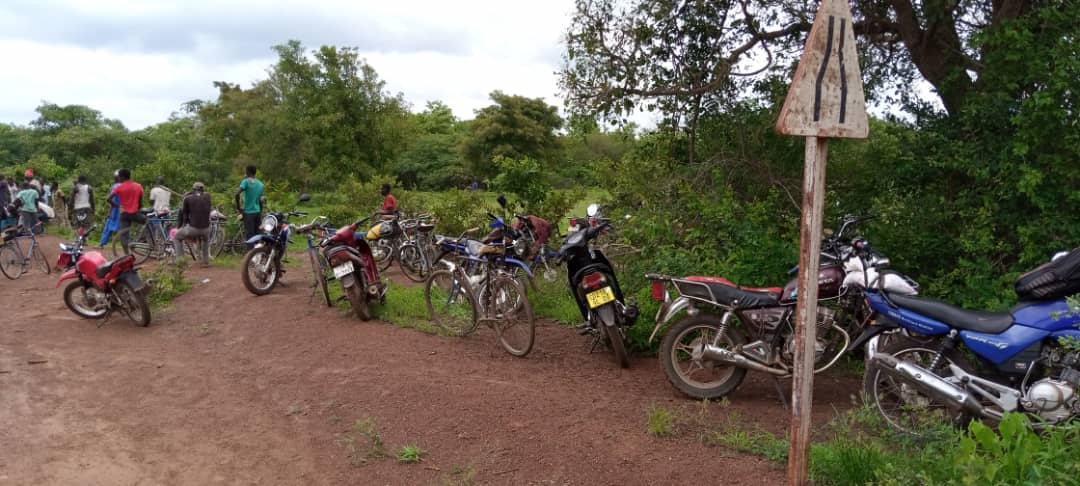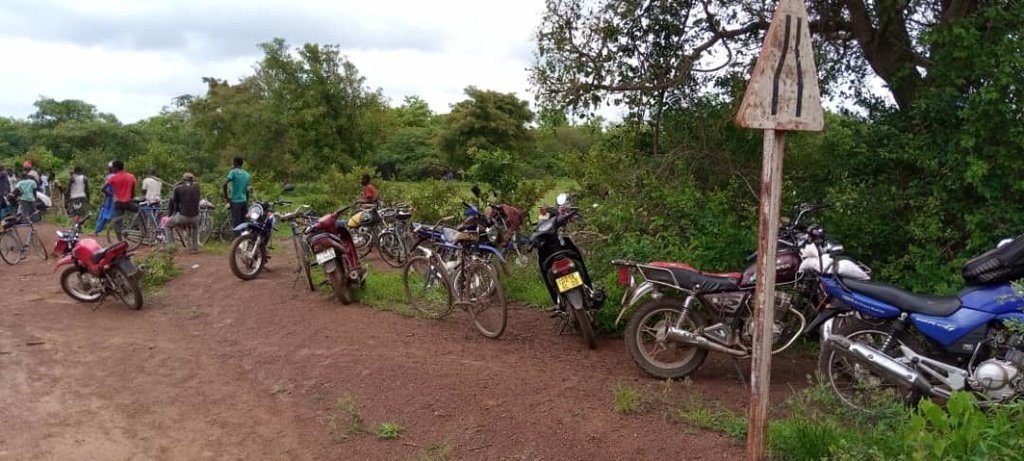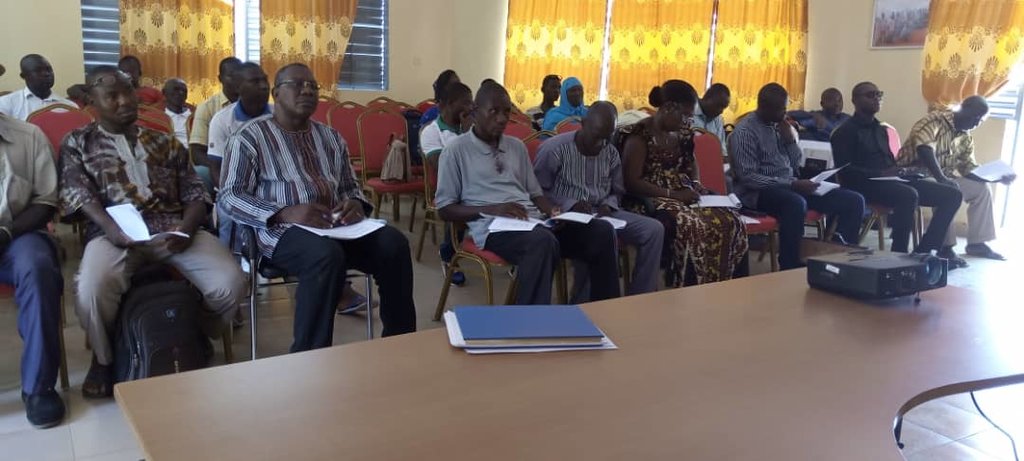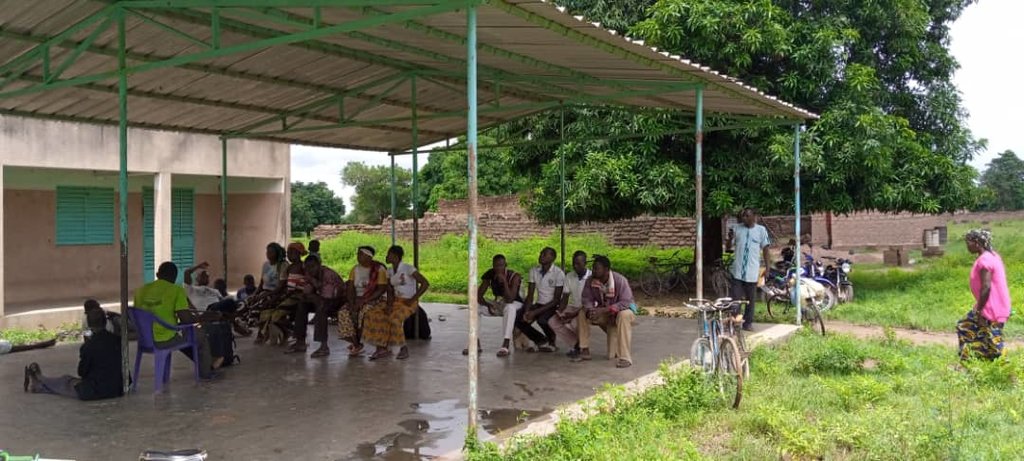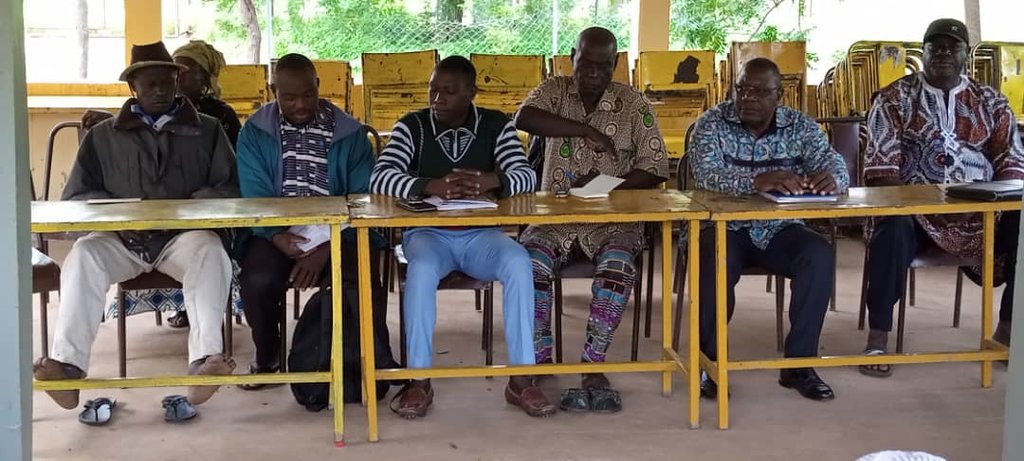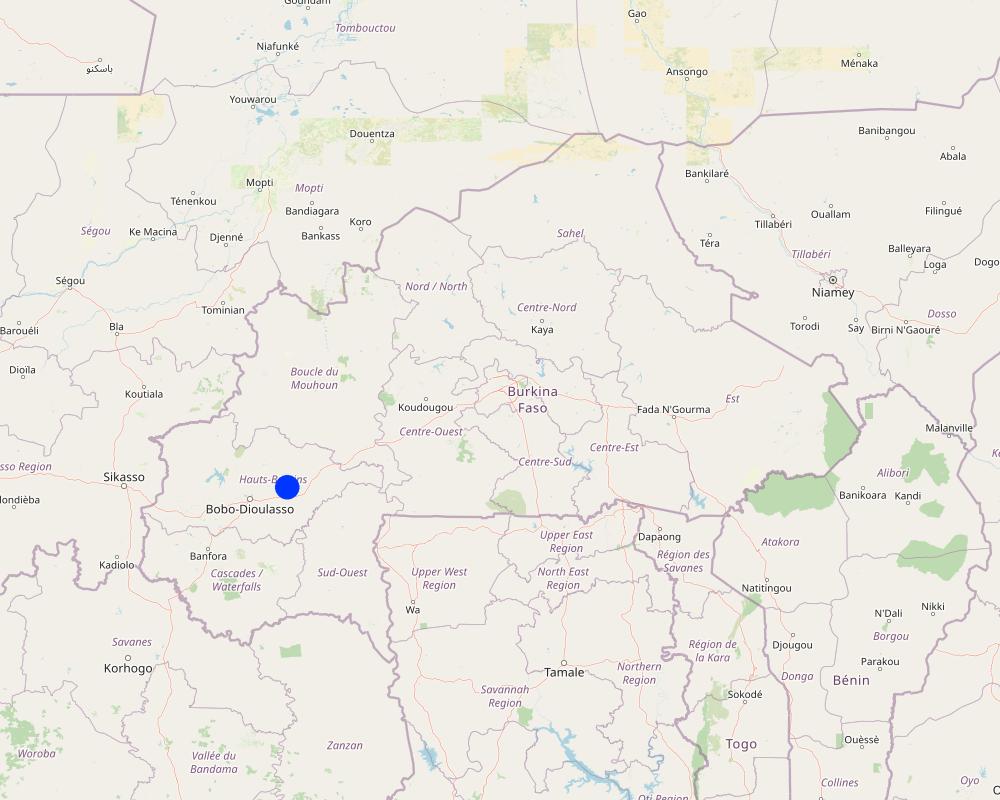Local Land Charter for Management of the Banks of the "Son" River [Burkina Faso]
- Creation:
- Update:
- Compiler: Moussa ABOU
- Editors: Brice Sosthène BAYALA, Siagbé Golli, Tabitha Nekesa, Ahmadou Gaye
- Reviewers: Sally Bunning, Rima Mekdaschi Studer, Joana Eichenberger, William Critchley
approaches_6696 - Burkina Faso
- Full summary as PDF
- Full summary as PDF for print
- Full summary in the browser
- Full summary (unformatted)
- Charte foncière locale relative à la gestion des berges de la rivière le « Son » de la Commune de Léna: July 20, 2023 (inactive)
- Charte foncière locale relative à la gestion des berges de la rivière le « Son » de la Commune de Léna: Sept. 14, 2023 (inactive)
- Local Land Charter for Management of the Banks of the "Son" River: May 20, 2024 (public)
View sections
Expand all Collapse all1. General information
1.2 Contact details of resource persons and institutions involved in the assessment and documentation of the Approach
Key resource person(s)
SLM specialist:
MILLOGO Chrisosthome
+22671318036 / +22676789622
millogo.dc@gmail.com
Mairie de Léna
Léna (Houet Province)
Burkina Faso
land user:
MILLOGO Maré
+22675902173 / +22660942907
Village Development Council (CVD)
Léna (Houet Province)
Burkina Faso
land user:
MILLOGO Issouf
+22676340160 / +22670421143
Village Development Council (CVD)
Léna (Houet Province)
Burkina Faso
land user:
MILLOGO Zézouma
+22655017752 / +22660241025
Village Development Council (CVD)
Léna (Houet Province)
Burkina Faso
Name of project which facilitated the documentation/ evaluation of the Approach (if relevant)
Soil protection and rehabilitation for food security (ProSo(i)l)Name of the institution(s) which facilitated the documentation/ evaluation of the Approach (if relevant)
Deutsche Gesellschaft für Internationale Zusammenarbeit (GIZ)1.3 Conditions regarding the use of data documented through WOCAT
When were the data compiled (in the field)?
17/01/2023
The compiler and key resource person(s) accept the conditions regarding the use of data documented through WOCAT:
Yes
2. Description of the SLM Approach
2.1 Short description of the Approach
This local land charter for river bank management sets out the common, consensual rules for managing the banks of the river "Son" in the commune of Léna. It applies to the entire communal territory of Léna and to all residents and non-residents.
2.2 Detailed description of the Approach
Detailed description of the Approach:
A Local Land Charter (CFL) focuses on the management of the banks of the "Son" river, which cross four villages within the Léna commune. These banks extend over a total distance of 31.8 kilometres, and the riparian buffer zone protecting them spans 100 meters on the left and right banks.
The objective is to enhance social cohesion through coordinated efforts to regulate the protection and sustainable utilization of the riverbanks, with a view to reducing and preventing conflicts and the degradation of soil and water resources. Authorized activities along the "Son" riverbanks include:
-water harvesting for domestic use, extraction of dead wood and timber, and collection of non-timber forest products (NTFPs) for human consumption or medicines;
-the planting of palm, bamboo, mango, cashew, and andropogon, as well as other crops authorized by the relevant authorities;
Key measures to adhere to in the exploitation of the "Son" riverbanks include:
- respect for bank and riparian buffer zones, cattle trail boundaries and watering points;
- prior authorization from the management committee and the department in charge of the environment in the Léna department for plantations not mentioned above, and from the relevant departmental services for the use of phytosanitary products for planting purposes;
-periodic maintenance of banks;
Discussions with operators and a literature review revealed that several practices and activities are prohibited under this approach. These include:
-water pollution caused by the use of chemical products and poor management of packaging for these products;
-making bricks on riverbanks;
-wood cutting;
-charcoal production
-bush fires;
-removal of aggregate from riverbeds and banks;
-the use of chemical substances or tree bark to weaken or poison fish;
The approach was implemented using a participatory and inclusive method, involving a scoping meeting, village general assemblies (AGVs), an in-depth resource diagnosis, feedback sessions, GPS surveys for resource delineation, negotiation of management rules, and drafting of the preliminary charter. Information and awareness-raising initiatives were crucial for successful implementation.
The main stages of the implementation process are as follows:
-the framing meeting;
-AGVs ;
-in-depth diagnosis of the resource
-resource delineation and production of cartographic support;
-feedback on diagnostic results;
-negotiation of management rules;
-drafting of the CFL preliminary project;
-an AGV to present the draft CFL;
-adoption of the draft CFL;
-transmission of the CFL to the High Commissioner;
-registration of the CFL in the commune's land register;
-application of management rules.
The main stakeholders involved in implementing the approach include the commune’s administration, the Village Development Council, representatives of rural producers' organizations, and technical and financial partners.
2.3 Photos of the Approach
2.5 Country/ region/ locations where the Approach has been applied
Country:
Burkina Faso
Region/ State/ Province:
Hauts-Bassins region/Houet province/Léna commune
Further specification of location:
Léna
Map
×2.6 Dates of initiation and termination of the Approach
Indicate year of initiation:
2021
Comments:
This local land charter may be revised at any time to reflect new expectations or concerns on the part of local population, and/or developments or changes to the banks of the "Son" River or to regulations. The revision shall be carried out in accordance with the same procedures and forms as those used to draw it up.
2.7 Type of Approach
- recent local initiative/ innovative
2.8 Main aims/ objectives of the Approach
-Regulate access to the banks of the "Son";
-Regulate exploitation of the banks of the "Son";
-Reduce resource degradation on the banks of the "Son";
-Strengthen social cohesion.
2.9 Conditions enabling or hindering implementation of the Technology/ Technologies applied under the Approach
social/ cultural/ religious norms and values
- enabling
Customary leaders are the custodians of customs and traditions. They are also responsible for fostering social harmony, and contribute to the prevention and management of conflicts associated with the enforcement of the local charter governing the management and exploitation of riverbank resource.
availability/ access to financial resources and services
- enabling
The availability of and access to financial resources and services can help build farmers' capacities, especially in terms of sustainable management of the Son riverbanks.
institutional setting
- enabling
The existence of a rural land service (SFR) within the Léna municipality provides a guarantee that the charter will be complied with and applied.
collaboration/ coordination of actors
- enabling
Stakeholder collaboration/coordination strengthens synergy in managing the banks of the "Son" River and social cohesion.
legal framework (land tenure, land and water use rights)
- enabling
Act 034-2009/AN of June 16, 2009 on rural land tenure and its implementing decrees support the implementation of this approach.
policies
- enabling
The national land tenure security policy in rural areas is an instrument that should contribute to the prevention and management of land conflicts, and to the consolidation of social peace.
land governance (decision-making, implementation and enforcement)
- enabling
Existing local land management bodies must ensure that the provisions of this approach are implemented and respected.
knowledge about SLM, access to technical support
- enabling
The stakeholder capacity-building activities undertaken under this approach have facilitated its implementation.
markets (to purchase inputs, sell products) and prices
- enabling
The close proximity to the city of Bobo-Dioulasso, the economic capital, provides an opportunity to purchase inputs and sell products at more favorable prices.
workload, availability of manpower
- enabling
The population of the Léna commune is predominantly young. This young population forms a pool of workers that can be used to implement this approach.
3. Participation and roles of stakeholders involved
3.1 Stakeholders involved in the Approach and their roles
- local land users/ local communities
Inform and raise public awareness while taking account of people's aspirations and interests.
- SLM specialists/ agricultural advisers
Their role is to consult all the village development councils concerned, offer their technical opinion on the draft charter, and ensure that the charter is respected and applied.
- NGO
Its role consisted of providing technical and financial support to the players involved in implementing the approach.
- private sector
Its role consisted of collaborating with technical departments and other players in implementing the approach.
- Service Foncier Rural
Under the responsibility of the mayor of the rural commune, the Rural Land Service (SFR) is responsible, in collaboration with the Village Development Council (CVD), customary and traditional authorities, the Decentralized Technical Services (STD) and local representatives of the regional chamber of agriculture, for the following main responsibilities:
-inventory, constitution and management of communal landholdings;
-inventory of local common-use resources, their preservation and participatory management;
-participation in the State's rural land inventory;
-keeping and regularly maintaining local land registers;
-carrying out procedures for establishing rural land ownership and drawing up rural land ownership certificates;
-participating in the drafting of local land charters and monitoring their application.
The rural land department is also responsible for :
-training, informing, raising awareness and assisting the rural population in securing land tenure in rural areas;
-participating in the creation of graphic documentation, the gradual creation of the communal land registry and the collection of land data;
-contributing to land management and disseminating information related to rural land deeds.;
-contributing to the demarcation of rural communes and to communal land use planning.
If several stakeholders were involved, indicate lead agency:
ProSoil
3.2 Involvement of local land users/ local communities in the different phases of the Approach
| Involvement of local land users/ local communities | Specify who was involved and describe activities | |
|---|---|---|
| initiation/ motivation | interactive | Local land users were involved in all stages of the implementation of the approach (information/awareness-raising, village general assembly meetings, in-depth diagnosis, resource delineation, presentation of the diagnostic results, negotiation of management rules, etc.). |
| planning | interactive | Land users were involved at all stages of the implementation of the approach. |
| implementation | none | At the time of collecting the data, the approach had not yet been implemented, but the charter had been drawn up, negotiated and adopted through a participatory process. |
| monitoring/ evaluation | none | There are plans for an annual evaluation of the implementation of the local land charter. This assessment aims to measure and analyze the degree to which the objectives outlined in the local land charter have been achieved. |
| Révision de la charte | interactive | This local land charter may be revised at any time, following the same procedures and formats employed in its initial drafting. |
3.4 Decision-making on the selection of SLM Technology/ Technologies
Specify who decided on the selection of the Technology/ Technologies to be implemented:
- all relevant actors, as part of a participatory approach
Explain:
The charter was developed using a participatory and inclusive approach.
Specify on what basis decisions were made:
- evaluation of well-documented SLM knowledge (evidence-based decision-making)
4. Technical support, capacity building, and knowledge management
4.1 Capacity building/ training
Was training provided to land users/ other stakeholders?
Yes
Specify who was trained:
- land users
- field staff/ advisers
Form of training:
- courses
Subjects covered:
• Elaboration of the local land charter;
• Workshop to prepare village assemblies with members of the initiative committee to draw up a land charter on the banks of Léna;
• Exchange workshop on the diagnostic tools used to draw up the Léna land charter.
4.2 Advisory service
Do land users have access to an advisory service?
Yes
Specify whether advisory service is provided:
- on land users' fields
Describe/ comments:
The decentralized technical services (Environment, Agriculture, Livestock, etc.) provide technical assistance to farmers in the performance of their activities.
4.3 Institution strengthening (organizational development)
Have institutions been established or strengthened through the Approach?
- yes, moderately
Specify the level(s) at which institutions have been strengthened or established:
- local
Describe institution, roles and responsibilities, members, etc.
As part of the implementation of the "Son" riverbank charter, a management committee (COGES) and a supervisory commission have been established. The COGES consists of fifteen (15) members, while the supervisory commission comprises thirteen (13) members.
The responsibilities of the Management Committee include:
•drafting the annual program of activities and submitting it to the special delegation for approval.
•implementing the approved program of activities.
•participating in all activities aimed at enhancing the banks of the "Son."
•monitoring the banks of the "Son" and ensuring compliance with the rules of the charter.
•collecting all taxes provided for and authorized by the special delegation.
•reporting on its management to the special delegation through an annual report.
The mission of the supervisory commission is to:
•monitor the banks of the "Son" and ensure compliance with the rules of the charter.
•immediately report any observed infringements to the management committee
Specify type of support:
- capacity building/ training
Give further details:
To enable these various bodies to fully play their roles, it is important to train them on their roles and responsibilities.
4.4 Monitoring and evaluation
Is monitoring and evaluation part of the Approach?
Yes
Comments:
An annual evaluation of the implementation of the local land charter is planned.
If yes, is this documentation intended to be used for monitoring and evaluation?
Yes
4.5 Research
Was research part of the Approach?
No
5. Financing and external material support
5.1 Annual budget for the SLM component of the Approach
If precise annual budget is not known, indicate range:
- 10,000-100,000
Comments (e.g. main sources of funding/ major donors):
ProSoil is the main source of funding.
5.2 Financial/ material support provided to land users
Did land users receive financial/ material support for implementing the Technology/ Technologies?
No
5.3 Subsidies for specific inputs (including labour)
- none
If labour by land users was a substantial input, was it:
- voluntary
5.4 Credit
Was credit provided under the Approach for SLM activities?
No
5.5 Other incentives or instruments
Were other incentives or instruments used to promote implementation of SLM Technologies?
No
6. Impact analysis and concluding statements
6.1 Impacts of the Approach
Did the Approach empower local land users, improve stakeholder participation?
- No
- Yes, little
- Yes, moderately
- Yes, greatly
The information and awareness-raising activities conducted before implementing the approach have enhanced stakeholder participation.
Did the Approach enable evidence-based decision-making?
- No
- Yes, little
- Yes, moderately
- Yes, greatly
The practices and activities authorized or prohibited on the banks of the "Son" were established based on the findings of an in-depth analysis of the resource.
Did the Approach help land users to implement and maintain SLM Technologies?
- No
- Yes, little
- Yes, moderately
- Yes, greatly
The approach has not been fully implemented in the field, and at this stage, we lack the information needed to make a comprehensive assessment. Nonetheless, it is important to highlight that one of the objectives of this approach is to guarantee the sustainable management of the banks of the "Son" River.
Did the Approach improve coordination and cost-effective implementation of SLM?
- No
- Yes, little
- Yes, moderately
- Yes, greatly
Since the approach is yet to be implemented, we have no data to assess its impact.
Did the Approach mobilize/ improve access to financial resources for SLM implementation?
- No
- Yes, little
- Yes, moderately
- Yes, greatly
Since the approach has not yet been implemented, there are no data available to assess its impact.
Did the Approach improve knowledge and capacities of land users to implement SLM?
- No
- Yes, little
- Yes, moderately
- Yes, greatly
Considering that the approach is yet to be implemented, it is difficult to assess how much land users' knowledge and skills have improved.
Did the Approach improve knowledge and capacities of other stakeholders?
- No
- Yes, little
- Yes, moderately
- Yes, greatly
Multiple stakeholders were engaged in the implementation of this approach. Throughout the implementation process, the capacities of these various parties were enhanced.
Did the Approach build/ strengthen institutions, collaboration between stakeholders?
- No
- Yes, little
- Yes, moderately
- Yes, greatly
As part of efforts to implement the approach, training courses and workshops were organized. These initiatives, combined with the establishment of an initiative committee, have enhanced collaboration among stakeholders.
Did the Approach mitigate conflicts?
- No
- Yes, little
- Yes, moderately
- Yes, greatly
The charter has been approved, but not yet implemented. At this stage, we are not in a position to assert that it has reduced conflict.
Did the Approach empower socially and economically disadvantaged groups?
- No
- Yes, little
- Yes, moderately
- Yes, greatly
This cannot be confirmed, since the approach is yet to be effectively implemented in the field.
Did the Approach improve gender equality and empower women and girls?
- No
- Yes, little
- Yes, moderately
- Yes, greatly
At this stage, it is difficult to assess the impact of the approach in terms of improving gender equality and empowering women and girls.
Did the Approach encourage young people/ the next generation of land users to engage in SLM?
- No
- Yes, little
- Yes, moderately
- Yes, greatly
Information and awareness-raising activities prior to the implementation of the approach have encouraged young people/the next generation of land users to get involved in SLM.
Did the Approach improve issues of land tenure/ user rights that hindered implementation of SLM Technologies?
- No
- Yes, little
- Yes, moderately
- Yes, greatly
Until the approach is implemented in the field, it will be difficult to assess its impact in terms of improving the issues of land tenure and user rights that impede the implementation of the technologies. However, we note that the aim of the charter is to improve these issues.
Did the Approach lead to improved food security/ improved nutrition?
- No
- Yes, little
- Yes, moderately
- Yes, greatly
The approach has only recently been put into practice, so we have little information to assess its impact in terms of improving food security and/or nutrition.
Did the Approach improve access to markets?
- No
- Yes, little
- Yes, moderately
- Yes, greatly
The approach has not yet been implemented.
Did the Approach lead to improved access to water and sanitation?
- No
- Yes, little
- Yes, moderately
- Yes, greatly
The approach is yet to be implemented, which makes it difficult at this time to assess its impact in terms of improving access to water and sanitation.
Did the Approach lead to more sustainable use/ sources of energy?
- No
- Yes, little
- Yes, moderately
- Yes, greatly
It is difficult to assess the impact of an approach where it has not yet been implemented.
Did the Approach improve the capacity of the land users to adapt to climate changes/ extremes and mitigate climate related disasters?
- No
- Yes, little
- Yes, moderately
- Yes, greatly
It is difficult to assess the impact of the approach in terms of improving land users' ability to adapt to climate change/extremes and mitigating climate-related disasters where it has not yet been implemented.
Did the Approach lead to employment, income opportunities?
- No
- Yes, little
- Yes, moderately
- Yes, greatly
Only when the approach is actually implemented will we be able to assess its impact on jobs and income opportunities.
6.2 Main motivation of land users to implement SLM
- reduced land degradation
Based on the diagnosis of the resource, it emerged that the "Son" is experiencing accelerated degradation of its resources, mainly as a result of silting up, anarchic occupation of the banks, water pollution, failure to observe buffer zones, excessive logging, the roaming of domestic animals, the slaughter of wild animals and illegal fishing.
- rules and regulations (fines)/ enforcement
This local land charter lays down common, consensual rules for managing the banks of the "Son" River in Léna.
- environmental consciousness
Land users are aware of the accelerated degradation of the resources along the banks of the "Son", and this is what prompted the initiative to implement this approach.
- conflict mitigation
Land users are convinced that this charter will help reinforce social cohesion, peace and make "living together" easier", thereby mitigating land conflicts within local communities.
6.3 Sustainability of Approach activities
Can the land users sustain what has been implemented through the Approach (without external support)?
- yes
If yes, describe how:
This approach is the outcome of a local initiative, and as such, farmers can continue implementing it without external support. It emerged from a consensus among the various stakeholders in the commune of Léna regarding the management of the banks of the Son.
6.4 Strengths/ advantages of the Approach
| Strengths/ advantages/ opportunities in the land user’s view |
|---|
| Conflict mitigation |
| Improved resource management |
| Strengths/ advantages/ opportunities in the compiler’s or other key resource person’s view |
|---|
| Enhanced social cohesion |
| Participatory and inclusive nature of the approach |
6.5 Weaknesses/ disadvantages of the Approach and ways of overcoming them
| Weaknesses/ disadvantages/ risks in the land user’s view | How can they be overcome? |
|---|---|
| Limited ownership of the charter | Continue efforts to inform users and raise their awareness regarding the charter |
| Weaknesses/ disadvantages/ risks in the compiler’s or other key resource person’s view | How can they be overcome? |
|---|---|
| Limited distribution of the charter | Provision of resources to disseminate the charter |
7. References and links
7.1 Methods/ sources of information
- field visits, field surveys
1
- interviews with land users
4
- interviews with SLM specialists/ experts
1
- compilation from reports and other existing documentation
3
7.2 References to available publications
Title, author, year, ISBN:
Commune de Léna, Charte foncière locale relative à la gestion des berges de la rivière « le Son » de la Commune de Lèna, 2022/Commune of Léna, Local land charter for the management of the banks of the river "Son" in the Commune of Léna, 2022
Available from where? Costs?
Available at the Léna Town Hall
Title, author, year, ISBN:
Burkina Faso, Loi 034-2009/AN Portant régime foncier au Burkina Faso, 2009/Burkina Faso, Act 034-2009/AN on land tenure in Burkina Faso, 2009
Available from where? Costs?
Available on the Internet
Title, author, year, ISBN:
Burkina Faso, Décret N°2010-400/PRES/PM/MAHRH/ MRA/MECV/MEF/MATD portant modalités d’élaboration et de validation des chartes foncières locales, 2010/Burkina Faso, Decree N°2010-400/PRES/PM/MAHRH/ MRA/MECV/MEF/MATD on the elaboration and validation of local land charters, 2010
Available from where? Costs?
Available on the Internet
Links and modules
Expand all Collapse allLinks
No links
Modules
No modules


